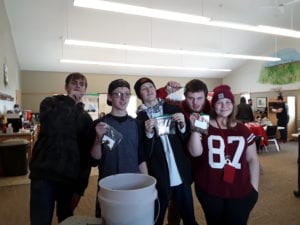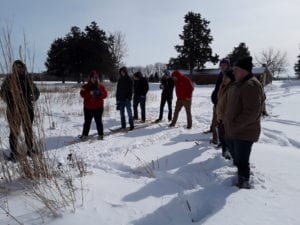By Sophie Bishop
How is water and land impacted by human activity? How are these problems escalated closer to agriculture and/or urbanization? The New Prague YES! team, the members of which come from both agricultural and urban areas, were wondering the same things. They wanted to know how their team can help bodies of water near New Prague and how we can bring back prairie lands. Jeremy and Jack from Sibley Soil & Water Conservation District, Karl from Le Sueur Soil & Water Conservation District, and Holly from Le Center Environmental Services spoke to the YES! team about these challenges. The experts presented on pollution and contaminate in Minnesota water, how we can help stop pollution before it starts, and how to clean it up once it has been introduced. During this talk, students had questions about how climate change actually works and how it is affecting our water and land. Many students had comments on how they have seen these problems in their everyday life.
 Afterwards, the students rotated between learning about aquatic invasive species, interacting with a water pollution table, and they even made their own seed bombs. Jack and Jeremy showed students common aquatic invasive species in Minnesota with real life specimens and how to combat against them. At the water pollution table, Karl and Holly helped students introduce pollutants (bottles with different color liquids) to the table to see how pollutants travel to bodies of water from different sources. The students got to then add techniques like better land management to the table to see how that lowers the input of pollutants into the water. Sophie, the YES! Program Coordinator, taught the students how to make seed bombs out of clay, soil, and native seeds. Everyone enjoyed being able to get dirty and make many different size bombs that they are able to bring back to school or their home.
Afterwards, the students rotated between learning about aquatic invasive species, interacting with a water pollution table, and they even made their own seed bombs. Jack and Jeremy showed students common aquatic invasive species in Minnesota with real life specimens and how to combat against them. At the water pollution table, Karl and Holly helped students introduce pollutants (bottles with different color liquids) to the table to see how pollutants travel to bodies of water from different sources. The students got to then add techniques like better land management to the table to see how that lowers the input of pollutants into the water. Sophie, the YES! Program Coordinator, taught the students how to make seed bombs out of clay, soil, and native seeds. Everyone enjoyed being able to get dirty and make many different size bombs that they are able to bring back to school or their home.
 After lunch, the students went out with all the experts snowshoeing to the native prairie and down to Frog Pond. Karl and Holly talked about different prairie plants, the importance of native plants, and how to manage the prairie while trampling through the tall grass. Jack and Jeremy explained how the ecosystem around a body of water functions, its importance and possible factors of pollutants. This journey started on top of the hills looking down on the frozen pond and then ended up snowshoeing across the ice.
After lunch, the students went out with all the experts snowshoeing to the native prairie and down to Frog Pond. Karl and Holly talked about different prairie plants, the importance of native plants, and how to manage the prairie while trampling through the tall grass. Jack and Jeremy explained how the ecosystem around a body of water functions, its importance and possible factors of pollutants. This journey started on top of the hills looking down on the frozen pond and then ended up snowshoeing across the ice.
Throughout this whole workshop, students learned about the importance of water quality management and native prairies. The New Prague YES! team left with great ideas on improving water quality in their hometown and how to create a native prairie landscape to better our land.
